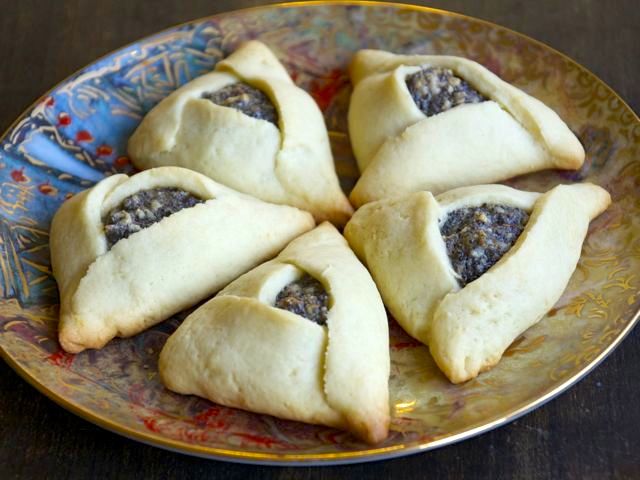Top | Cookies, Brownies, and Bar Cookies
Hamantaschen
(recipe, Carrie Floyd)

primary-image, l
Introduction
These hamantaschen combine two recipes: a cream cheese-butter dough adapted from the late Richard Sax's Classic Home Desserts, and the filling from Joan Nathan's Quiches, Kugels, and Couscous, a book on Jewish cooking in France.
Unlike canned poppy-seed filling — too sweet for me, and full of dubious ingredients besides — Nathan's recipe is a complex blend of poppy seeds, dried fruit, nuts, and lemon zest. I also like the cookies filled with apricot or raspberry preserves; Nathan says that French children like Nutella in their hamantaschen.
Translated as "Haman's pockets," these cookies are traditional for Purim. As Sax writes: "The pastries are supposed to represent the hat worn by Haman, counselor to the king and the villain in the Purim story. Purim is a time to take gifts of food to the homes of friends and to drink wine — according to the Talmud, 'until you no longer know the difference between the names of Mordecai and Haman.'"
Check out either The Shiksa in the Kitchen or Melissa Clark's website for tips and photos on shaping hamantaschen.
Ingredients
Dough
- ¼ cup (½ stick) unsalted butter, softened
- 4 oz. (½ cup) cream cheese, softened
- ½ tsp. vanilla
- Zest of 1 lemon
- ½ cup sugar
- 1 large egg
- 2 cups all-purpose flour
- 1 tsp. baking powder
- ¼ tsp. salt
Filling
- ¼ cup poppy seeds
- ¼ cup milk
- ¼ cup sugar
- 5 pitted dates or figs, chopped
- 2 Tbsp. raisins
- 5 walnuts, roughly chopped
- ¼ cup plus 2 T. ground almonds
- Zest of 1 small lemon
- 1 small egg yolk
Steps
- Make the dough: Cream together the butter, cream cheese, vanilla, and lemon zest in the bowl of an electric mixer. Slowly add the sugar, then beat in the egg. Add the flour, baking powder, and salt, and beat until just incorporated; do not over-mix. Shape the dough into a disk, wrap in plastic wrap, and chill for at least 30 minutes.
- Make the filling: Place the poppy seeds in a small saucepan and cover with the milk. Simmer for a couple of minutes, stirring occasionally, then turn off heat and let cool. Place the sugar, dates or figs, raisins, nuts (both the walnuts and almonds), lemon zest, and egg yolk in a bowl, and add the poppy seed-milk mixture. Transfer to a food processor with a steel blade and pulse until just combined. Refrigerate until the filling is chilled.
- Prep for baking: Remove the dough and filling from the refrigerator and preheat the oven to 350 degrees. Line baking sheets with silicone mats or parchment paper, or grease the sheets with butter.
- Assemble the cookies: Because the dough is so sticky, it works best to roll it out between two floured pieces of plastic wrap. Lightly flour the plastic wrap, place the dough between the wrap, and roll out to ⅛-inch thickness. Using a biscuit cutter or drinking glass, floured on the rim, cut the pastry into 3-inch circles. Mound a teaspoon of chilled filling in the center of each circle of dough. Brush water around the rim of the circle (this helps to seal the dough), then shape into triangles, pinching the dough at the corners. Transfer the filled rounds onto the prepared baking sheets.
- Bake the cookies: Bake on doubled pans (stack an empty baking sheet under each sheet with cookies) until the hamantaschen are pale gold on top, 25 to 30 minutes. Cool on wire racks and serve at room temperature.

